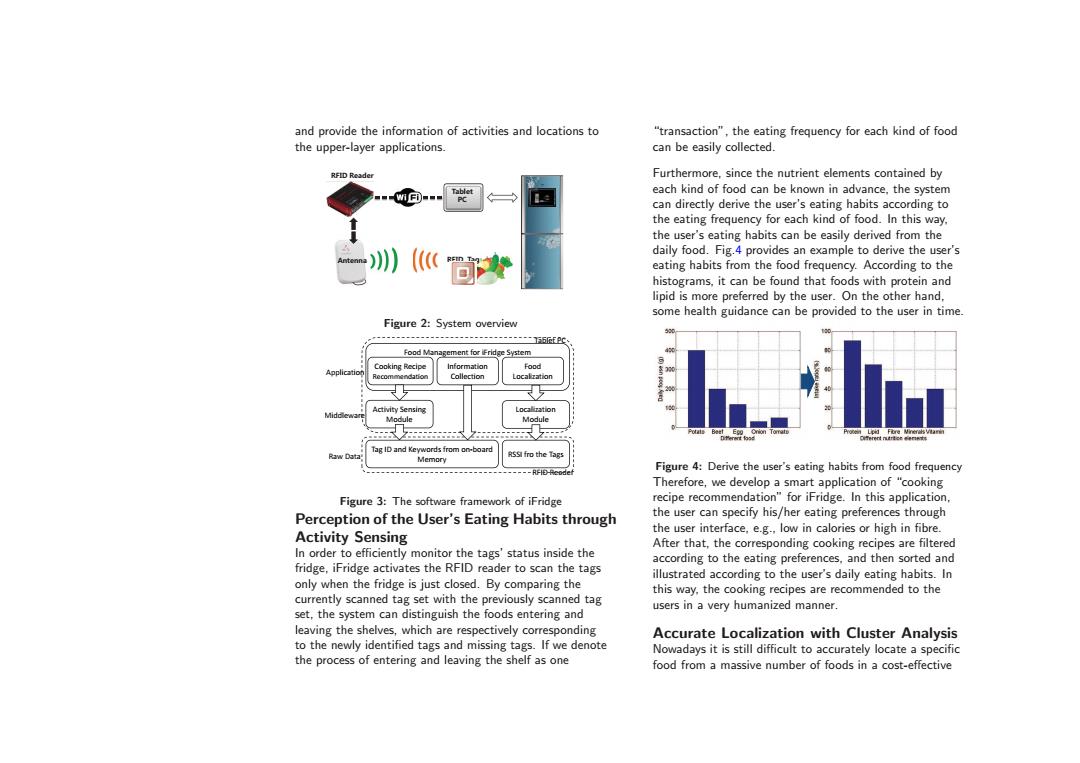正在加载图片...

and provide the information of activities and locations to "transaction",the eating frequency for each kind of food the upper-layer applications. can be easily collected. Furthermore,since the nutrient elements contained by each kind of food can be known in advance,the system can directly derive the user's eating habits according to the eating frequency for each kind of food.In this way. the user's eating habits can be easily derived from the daily food.Fig.4 provides an example to derive the user's eating habits from the food frequency.According to the histograms,it can be found that foods with protein and lipid is more preferred by the user.On the other hand. some health guidance can be provided to the user in time. Figure 2:System overview Food Mar gement for Fridge System Cooking Recipe Information Food ctivity Sensin ag ID and Keywords from on-bo Memory RSSI fro the Tags -------RFI6-Rcodef Figure 4:Derive the user's eating habits from food frequency Therefore,we develop a smart application of "cooking Figure 3:The software framework of iFridge recipe recommendation"for iFridge.In this application, Perception of the User's Eating Habits through the user can specify his/her eating preferences through Activity Sensing the user interface.e.g..low in calories or high in fibre. After that,the corresponding cooking recipes are filtered In order to efficiently monitor the tags'status inside the according to the eating preferences,and then sorted and fridge,iFridge activates the RFID reader to scan the tags illustrated according to the user's daily eating habits.In only when the fridge is just closed.By comparing the this way,the cooking recipes are recommended to the currently scanned tag set with the previously scanned tag set,the system can distinguish the foods entering and users in a very humanized manner. leaving the shelves,which are respectively corresponding Accurate Localization with Cluster Analysis to the newly identified tags and missing tags.If we denote Nowadays it is still difficult to accurately locate a specific the process of entering and leaving the shelf as one food from a massive number of foods in a cost-effectiveand provide the information of activities and locations to the upper-layer applications. 8,/*8KGJKX 'TZKTTG :GHRKZ 6) 8,/*:GM Figure 2: System overview Tag ID and Keywords from on!board Memory RSSI fro the Tags Localization Module Activity Sensing Module Food Management for iFridge System Cooking Recipe Recommendation Food Localization Information Collection Tablet PC RFID Reader Raw Data Middleware Application Figure 3: The software framework of iFridge Perception of the User’s Eating Habits through Activity Sensing In order to efficiently monitor the tags’ status inside the fridge, iFridge activates the RFID reader to scan the tags only when the fridge is just closed. By comparing the currently scanned tag set with the previously scanned tag set, the system can distinguish the foods entering and leaving the shelves, which are respectively corresponding to the newly identified tags and missing tags. If we denote the process of entering and leaving the shelf as one “transaction”, the eating frequency for each kind of food can be easily collected. Furthermore, since the nutrient elements contained by each kind of food can be known in advance, the system can directly derive the user’s eating habits according to the eating frequency for each kind of food. In this way, the user’s eating habits can be easily derived from the daily food. Fig.4 provides an example to derive the user’s eating habits from the food frequency. According to the histograms, it can be found that foods with protein and lipid is more preferred by the user. On the other hand, some health guidance can be provided to the user in time. Figure 4: Derive the user’s eating habits from food frequency Therefore, we develop a smart application of “cooking recipe recommendation” for iFridge. In this application, the user can specify his/her eating preferences through the user interface, e.g., low in calories or high in fibre. After that, the corresponding cooking recipes are filtered according to the eating preferences, and then sorted and illustrated according to the user’s daily eating habits. In this way, the cooking recipes are recommended to the users in a very humanized manner. Accurate Localization with Cluster Analysis Nowadays it is still difficult to accurately locate a specific food from a massive number of foods in a cost-effective��������